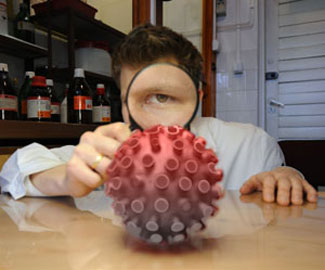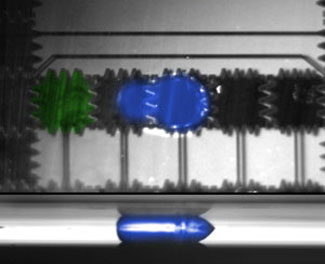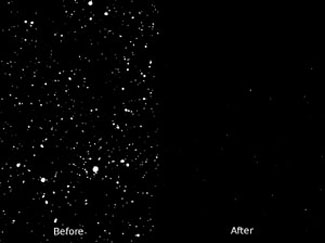| Jun 08, 2011 |
Walking microdroplets collect viruses and bacteria
|
|
(Nanowerk News) A barely visible, electric-field-controlled droplet moves on an appropriately prepared surface, harvesting viruses, bacteria and protein molecules deposited thereon. This is how a novel method of collecting bioparticles looks like in real life. The method has been for the first time successfully tested by a team of researchers from the Institute of Physical Chemistry of the Polish Academy of Sciences and the French Institut d'Electronique, de Microélectronique et de Nanotechnologie and the Institut de Recherche Interdisciplinaire. The results of the tests will have an impact on the development of microsystems for chemical analyses, especially those dedicated to monitor bioparticles present in the air.
|
|
The future of chemistry are miniaturised devices designed to carry out reactions and chemical analyses. The fabrication of such systems, popularly called "labs on chip", is seriously challenging the engineers. "You can make an excellent microfabricated analytical system, but to make it work you still have to prepare the sample in a proper way", says Dr Martin Jönsson-Niedziolka from the Institute of Physical Chemistry of the Polish Academy of Sciences (IPC PAS), adding: "Assume we have viruses and bacteria on a surface. Would we try to simply wash the surface with water, and then introduce a droplet of that water into a microanalyser, the result would be poor. Just because the concentration of the pollutants will be too low".
|
 |
| Dr Martin Jönsson-Niedziolka from the Institute of Physical Chemistry of the Polish Academy of Sciences studies the methods of surface cleaning by removing bioparticles using electric-field-controlled microdroplets. (Source: IPC PAS/Grzegorz Krzyzewski)
|
|
To ensure the highest possible concentration of bioparticles, it is better to use a small water droplet, just a microliter in volume. Such a droplet is introduced between two plates: a lower one with pollutant particles earlier deposited electrostatically, and a top one, coated with a system of small electrodes and an insulating layer (protecting against current flow through the droplet, which could lead to electrolysis). By making use of a phenomenon called electrowetting and applying voltage in a proper way, the droplet can be precisely displaced over the surface and so collect bioparticles from the entire plate. An additional advantage of the method is that the sample collected is already in the liquid state as required by many measurement methods. Moreover, as the displacement of the microdroplet is easy to control, the problem of how to deliver the sample to further lab-on-chip components disappears.
|
|
The systems with microdroplets have been fabricated and tested for a couple of years. A group of researchers from the Institute of Physical Chemistry of the PAS (Dr Martin Jönsson-Niedziolka) and the French Institut d'Electronique, de Microélectronique et de Nanotechnologie (Dr Vincent Thomy) and the Institut de Recherche Interdisciplinaire (Dr Rabah Boukherroub) had doubts about the fact that all earlier reports on microdroplets described the collection of latex microspheres from the surface. These particles are used because they are easily available in various sizes and safe in tests. It was not clear if the microdroplets would equally efficiently collect real bioparticles, such as bacterial spores or viruses.
|
 |
| Microdroplet (blue) displacement on a superhydrophobic surface stimulated by 60 V voltage, top and side views. The area of each electrode (green) was 2 mm2. Artificial colours. (Source: IPC PAS)
|
|
The study made use of a microdevice fabricated by the French group. The particles investigated in tests included inactive bacteriophage MS2 (virus that infects bacteria), Bacillus atrophaeus spores and OA (ovalbumin) proteins. The bioparticles were deposited on two different surfaces. One of them was a hydrophobic surface, coated with a substance that resembles Teflon. The other plate was fabricated using nanowires (1 micrometer long) and its hydrophobicity was close to that characteristic for the famous lotus leaves. Until now, such superhydrophobic surfaces were not studied in any microdevices making use of electrowetting.
|
|
In experiments with viruses, the type of surface they were deposited on did not have any significant effect on the microdroplet cleaning efficiency. The cleaning efficiency was 98-99% and was higher than that typical for latex particles (92-93%). Different results have been found, however, for spores and protein molecules. High cleaning efficiency was found here for superhydrophobic surface only (99 and 92%, respectively), whereas the corresponding figures for hydrophobic surface were distinctly lower (46% and 71%, respectively).
|
 |
| Surface before (left) and after cleaning (right) by removing bioparticles using an electric-field-controlled microdroplet. An image from fluorescence microscope. (Source: IPC PAS/Grzegorz Krzyzewski)
|
|
The findings published in the prestigious journal Lab on a Chip ("EWOD driven cleaning of bioparticles on hydrophobic and superhydrophobic surfaces") demonstrate that the surface cleaning efficiency using microdroplets strongly depends on both the type of collected particles and the hydrophobic properties of the surface. "Everyone who wants to collect efficiently various bioparticles using microdroplets should use superhydrophobic surfaces", sums up Dr Jönsson-Niedziolka.
|
|
The Institute of Physical Chemistry of the Polish Academy of Sciences (http://www.ichf.edu.pl/) was established in 1955 as one of the first chemical institutes of the PAS. The Institute's scientific profile is strongly related to the newest global trends in the development of physical chemistry and chemical physics. Scientific research is conducted in nine scientific departments. CHEMIPAN R&D Laboratories, operating as part of the Institute, implement, produce and commercialise specialist chemicals to be used, in particular, in agriculture and pharmaceutical industry. The Institute publishes approximately 200 original research papers annually.
|



